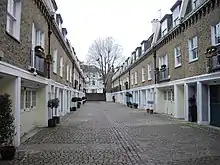Christopher Bowerbank
Christopher William Bowerbank (17 November 1940 – 25 April 2002) was an English architect and raconteur.[1] Bowerbank's obituary in The Daily Telegraph described him as a ‘celebrated member of West London society and one of the best conversationalists of his generation’.[2][3] Will Self recalled that Bowerbank had the ability to transition between the "haut, beau and demi-mondes". In his later years Bowerbank, ‘with his shock of grey hair and a look of glittering purpose’, was said to resemble Beethoven.[2][3]
Christopher William Bowerbank | |
|---|---|
| Born | 17 November 1940 Biddestone, Wiltshire, England |
| Died | 25 April 2002 (aged 61) Notting Hill, London, England |
| Education | Sherborne School |
| Alma mater | Architectural Association School of Architecture |
| Relatives | Great uncle: Sir Fred Thompson Bowerbank |
In his early years as an architect, Bowerbank lived in Camden in the same house as Bruce Robinson, the film producer.[2][3][4] Bowerbank's Jaguar was said to be the inspiration behind the mode of transport to Penrith in Robinson's cult classic film Withnail and I.[5]
At the time of Bowerbank's death he was engaged to Emma Soames, the editor of The Daily Telegraph magazine and granddaughter of Winston Churchill.[2][3][6] According to his obituary in The Daily Telegraph, Bowerbank 'talked to everyone with the same charm and vigorous attack – whether it was Princess Margaret or the locals on his beloved Orkney island of Rousay, where he had a home for more than 25 years’.
Early life
Christopher William Bowerbank was born on 17 November 1940 in Biddestone, Wiltshire.[2][3] He was the son of a Royal Navy Commander, Geoffrey Bowerbank, and Mary Winifred Bowerbank (née Kirtley), and educated at Sherborne School where he shared a study with Nigel Dempster.[2][3] Bowerbank matriculated at the Architectural Association School of Architecture, graduating with a first, and afterwards turned down two scholarship offers to study English at Columbia University, New York.[2][3] Sir Peter Cook was influential on Bowerbank's architectural style.[1]
Architectural career

After the AA, Bowerbank attempted a series of apprenticeships which were not to his liking.[2][3] He temporarily and characteristically ended up an escort and driver to Marianne Faithfull through whom he gained a commission to design the headquarters of Impact Records, then the record label of The Rolling Stones.[2][3] The headquarters were never constructed but the experience set up Bowerbank as an independent architect for the rest of his professional life.[2][3]
Bowerbank built his practice in London's Fitzrovia, behind Bertorelli's Restaurant on Charlotte Street.[2][3] He was never a modernist in architectural style: when asked to extend or modify an old building, he would not seek to detract from the original, reflecting his respect for British style and tradition.[2][3][7] Bowerbank worked on both residential and commercial buildings and he was noted for his sympathetic restoration of listed buildings, particularly in London.[1][8] His work often required complex negotiations with English Heritage and council planners.[1]

Bowerbank's work included the headquarters for Radiodetection in Bristol, work on Redcliffe Mews in London and Howabreck House on Orkney.[3][9] In 1990, he won an English Heritage award for his renovation work on The Convent in Stourhead, Wiltshire, which was Grade I listed.[10][11]
Personal life
From an early age, Bowerbank was an amateur ornithologist.[2][3] He rarely talked about his professional work, preferring instead to talk about literature, philosophy and the European Union, the latter being a subject on which he was a firm critic.[2][3] At the time of Bowerbank's death he was engaged to Emma Soames, granddaughter of Winston Churchill and then the editor of The Daily Telegraph magazine.[2][3][6]
Bowerbank's great uncle was Sir Fred Thompson Bowerbank, Hon. Physician to King George VI.[5][12] For 25 years, Bowerbank had a home on the island of Orkney, Viera Lodge, where he entertained friends from London and engaged in his love of ornithology.[6][13]
Bowerbank died in his sleep in Notting Hill on 25 April 2002, aged 61.[6]
References
- Spike, Paul (3 May 2002). "Obituary: Christopher Bowerbank". The Guardian. Retrieved 17 June 2019.
- Obituary in The Daily Telegraph, Christopher Bowerbank, 30 April 2002
- "Christopher Bowerbank". The Daily Telegraph. 29 April 2002. Retrieved 17 June 2019.
- Hewitt-McManus, Thomas (13 March 2013). Withnail & I: Everything You Ever Wanted to Know But Were Too Drunk to Ask. Lulu Press, Inc. ISBN 9781105699726. Retrieved 17 June 2019 – via Google Books.
- "Ancestry – Genealogy, Family Trees & Family History Records". ancestry.co.uk. Retrieved 17 June 2019.
- Barber, Lynn (1 December 2002). "Lynn Barber meets Emma Soames, the new editor of Saga Magazine". The Guardian. Retrieved 17 June 2019.
- Holt, Jonathan (15 May 2019). Wiltshire Follies. Amberley Publishing. ISBN 9781445684901. Retrieved 17 June 2019 – via Google Books.
- Werner, Frank (1 April 1982). New living in old houses. H.N. Abrams. Retrieved 18 June 2019 – via Internet Archive.
christopher bowerbank .
- "English Architect Christopher Bowerbank Dies". artdaily.com. Retrieved 18 June 2019.
- balancearchitecture (8 November 2018). ""It was pure Folly!" Architectural Follies". Retrieved 18 June 2019.
- Gilliatt, Mary (9 February 1991). The Perfect Home. Portland House. ISBN 9780517051818. Retrieved 18 June 2019 – via Google Books.
- Bowerbank, Fred (17 June 2019). A doctor's story. Tombs. OCLC 11358841. Retrieved 17 June 2019 – via Open WorldCat.
- "Will Self on Charles Maclean's St Kilda: Island on the Edge of the World". New Statesman. Retrieved 18 June 2019.